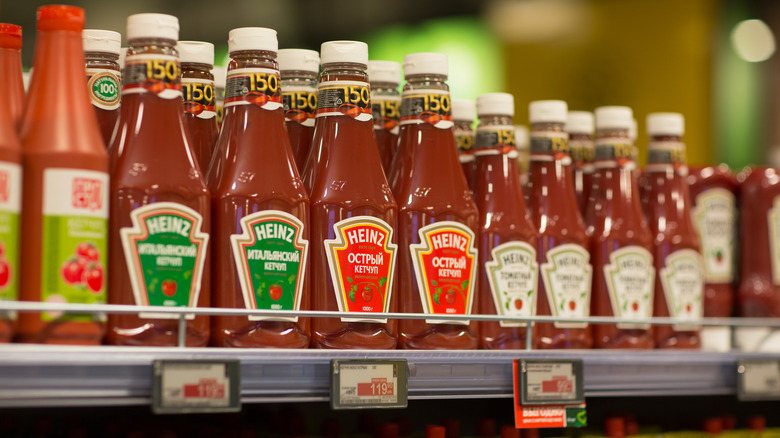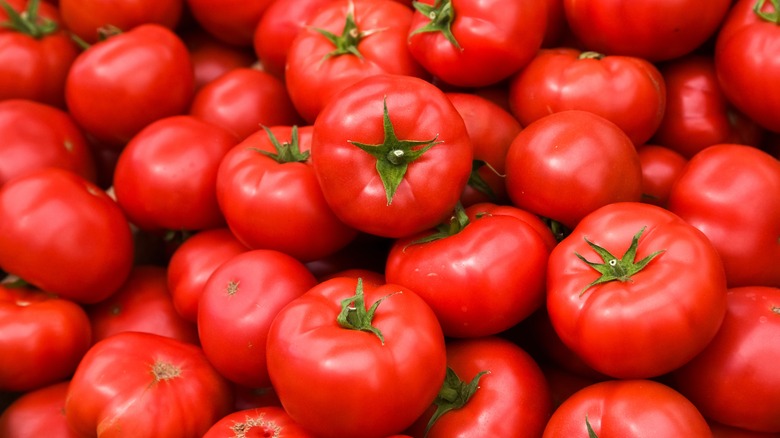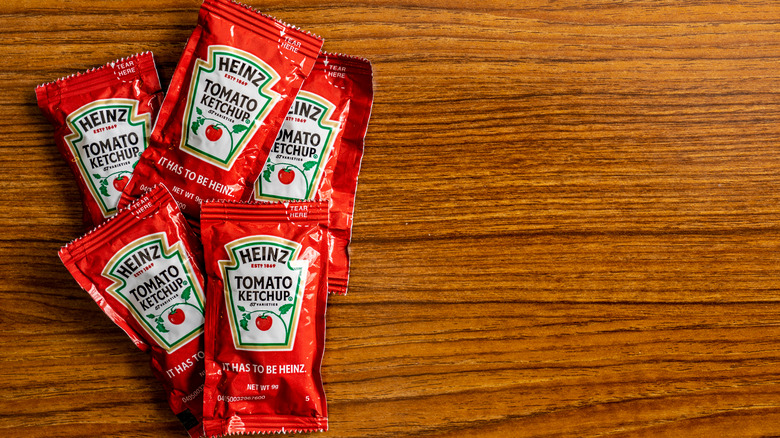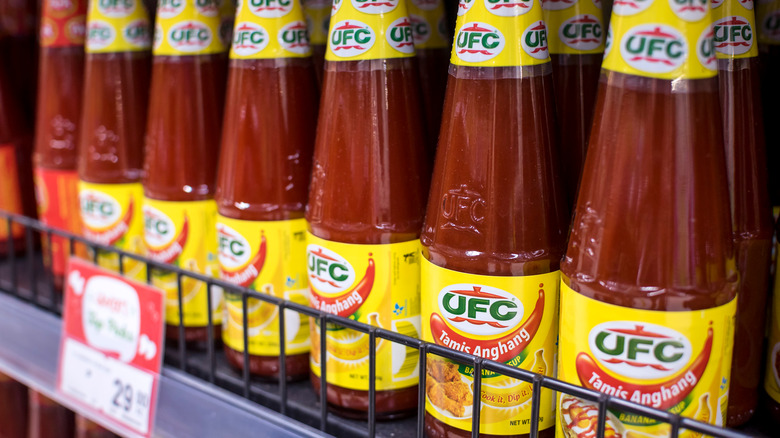The Early History Of Ketchup Has Nothing To Do With Tomato
If there is one condiment that can be most closely associated with American cuisine, ketchup must be at the top of the list. The ubiquitous thick, tomato-based sauce is now mostly linked to Henry J. Heinz, who started packaging it for customers in 1876. Today, you can find ketchup in just about every restaurant that serves American-style food, from the humble diner to upscale steakhouses. Every day, somewhere in the world, someone is squeezing ketchup on top of hamburgers, hot dogs, and french fries.
However, have you ever wondered about the origins of ketchup? Despite being intrinsically linked to America, ketchup was not invented in the United States. In fact, the original ketchup is so far removed from the thick tomato-derived sauce that it has almost nothing in common with the modern version. To trace the origins of ketchup, we have to go back to Asia — specifically, to imperial China.
The Chinese origin of ketchup
Most scholars have traced the origin of ketchup to China, where a sauce made with fermented fish has been produced in the southeastern provinces since at least 300 BC. Eventually, the same fermentation methods were applied to soybeans, creating fermented bean paste. Over time, soy supplanted fish as the dominant ingredient in sauce and paste making in China, as it was more accessible, cheaper to use, and more adaptable to different tastes. However, fish paste and sauce manufacturing continued in Southeastern China, and the practice also persisted in Southwest Asia, a region that includes Vietnam and Thailand, among others.
Western traders most likely encountered fish sauce through the Hoklo people, who called it "kôe-chiap" or "kê-chiap" in the Hokkien dialect. It is speculated that the British first encountered the condiment at one of their trading posts in Indonesia in the late 17th century, and from there, the term "catchup" entered the English vocabulary. This was further proven by a Hokkienese-to-English dictionary, which equated the term to fish sauce. In modern-day Indonesia, the word "kecap" usually refers to any soy or fish-based fermented sauce.
Evolution of ketchup in Europe
The original ketchup as made in Southeast Asia was a paste made with fish entrails that had been rinsed, rubbed with salt, and sealed in jars before being left outdoors to ferment in the sun for weeks. Strained from the solids, ketchup was dark in color and thin in texture, not unlike modern fish sauce you can buy from any Asian grocery store today. Thanks to its high salinity and intense fermentation, it was well suited for long voyages, allowing British and Dutch traders to bring it to their homelands, where it became popular in the 18th century.
Eager to reproduce the umami found in the original ketchup, Europeans started experimenting with different ingredients. The first known printed English language recipe for ketchup, published in 1727, described a process that involved combining white wine, wine vinegar, shallots, anchovies, mace, cloves, lemon peel, and horseradish in a bottle before leaving it to ferment. Other recipes of ketchup at the time involved ingredients such as walnuts and mushrooms. For example, the author Jane Austen's best friend Martha Lloyd documented a recipe of a version made with walnuts. These early prototypes of ketchups were often mixed into other sauces as a seasoning instead of used as a condiment.
Enter the tomato
Although tomatoes were known to Europeans since the discovery of the Americas in the 15th century, they were not consumed for years to come. While the Aztecs used them as food, Europeans brought them across the ocean only as ornamental plants, thinking that the plant was poisonous. However, tomatoes slowly entered the European diet, beginning with the Spanish and later spreading to other Mediterranean countries. Printed recipes involving tomatoes did not appear until late in the 17th century.
While tomatoes and ketchup coexisted for another century in Europe, no one thought of marrying them until 1812, when the first known recipe for tomato ketchup was published by a scientist named James Mease. A couple of decades later, tomato-based ketchup quickly became popular thanks to doctor John Cook Bennett's enthusiastic promotion of tomatoes as a health food that could prevent and cure a host of diseases. As a result, the preparation and use of tomato ketchup became widespread throughout the United States. Some recipes even included anchovies, an echo of the sauce's origins as a fish sauce. With its popularity soaring after the Civil War, food manufacturers began making mass-produced versions of the condiment.
Heinz and the modern ketchup
The industrialization of ketchup-making contributed heavily to the taste of modern ketchup. Due to tomatoes' short growing season, and their tendency to spoil quickly, companies began experimenting with ways to prolong the life of the tomato pulp used to make ketchup. Unsavory chemicals such as coal tar and sodium benzoate were added to maintain a red color and prevent spoilage, but these artificial ingredients were seen as harmful to human health.
Enter Dr. Harvey Washington Wiley, an opponent of artificial preservatives. Partnering with Henry J. Heinz, who had been producing tomato ketchup since 1876, they developed a new way to make ketchup using whole ripe tomatoes, vinegar, brown sugar, salt, and spices. By using ripe tomatoes, which contain the natural preservative pectin, and increasing the amount of vinegar and sugar, Heinz invented a ketchup that did not need additional preservatives. To emphasize its naturalness, Heinz used a clear bottle to showcase the freshness and vibrant color of the product. When it was launched in 1906 to widespread popularity, the modern ketchup as we know it was born.
Ketchup everywhere
Today, dozens of different types of tomato ketchup grace store shelves, and the condiment has become a global sensation. From dipping fast-food french fries to glazing meatloaf at home, ketchup is added to everything, including cottage cheese (an alleged favorite of Richard Nixon) and pizza. You can even use a ketchup marinade for hot dogs. In fact, ketchup's popularity is perhaps only rivaled by another tomato-based condiment: salsa.
However, have you ever heard of a popular ketchup that has nothing to do with tomatoes? Yes, really. Famous in the Philippines and parts of the Caribbean, this variant offers a similar taste and consistency to its tomato counterpart, but with a sweeter and fruitier finish. The secret ingredient? Bananas. Known as either banana ketchup or banana sauce, it's used almost interchangeably with tomato ketchup. Intriguingly, banana ketchup is even dyed red with food coloring, making it visually indistinguishable with tomato ketchup.






